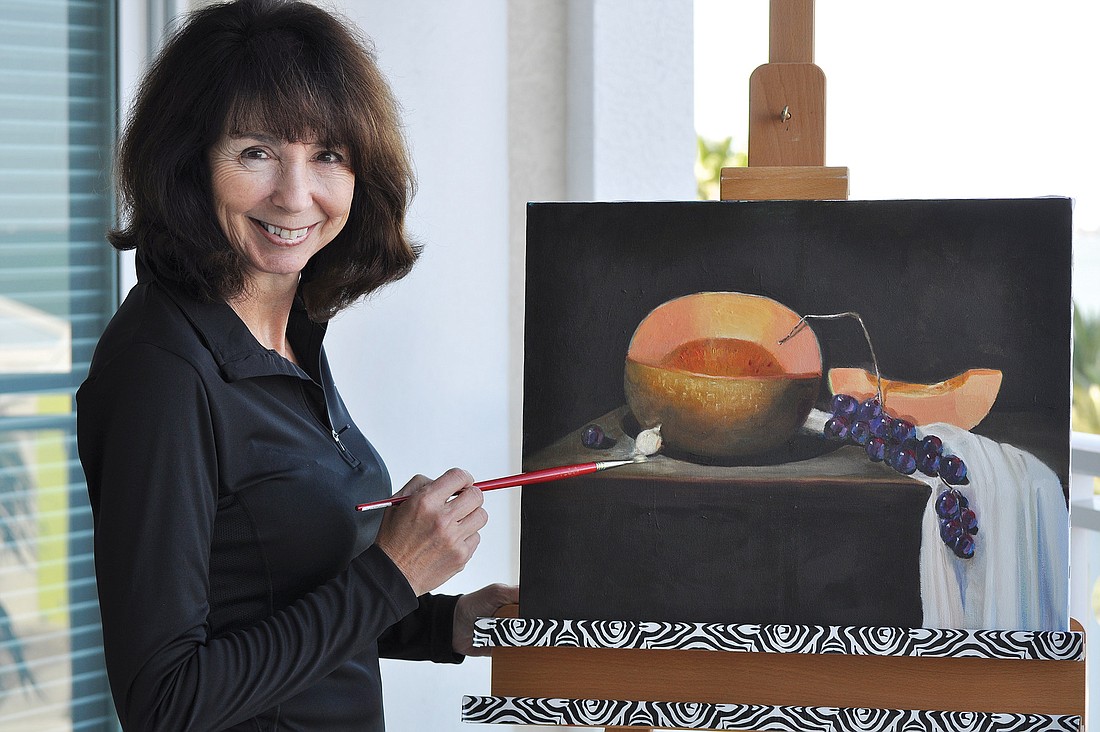- April 18, 2024
-
-
Loading

Loading

Jazz music is blasting from Nancy Markle’s downtown Sarasota condominium. The music is so loud that it can be heard from the elevator that opens to her unit.
It seems kind of early to be listening to music this loud — 10 a.m. Markle, however, doesn’t seem to notice.
She’s spent most of her life in business suits and skirts navigating the quiet IT departments of Fortune 100 companies. If she wants to spend her Tuesday mornings listening to loud jazz inside her waterfront condo, so be it.
Barefoot and dressed in a black tracksuit, she shuffles around her kitchen fixing coffee and tea.
“Cream and sugar?” Markle asks politely over the roar of saxophones and trumpets.
She grew up in Georgia, but she doesn’t have, as she describes it, “a little Southern accent like a Georgia peach.”
A familiar face on the Sarasota social circuit, Markle is the former CIO of the Americas at Arthur Andersen and a longtime board member of the Asolo Repertory Theatre.
She’s also an extraordinary painter, whose work has taken a backseat to, of all things, a career in computing.
“I promised myself I would retire early so I could do art,” Markle says. “Then I flunked retirement.”
Up until last year, she spent her retirement working as an IT consultant, advising executives on matters that would make most artists cringe: innovative technologies, strategic planning, project management and systems development.
She gave it up to focus on painting.
“I think I’m happier and more relaxed now,” she says of the decision. “I’m more appreciative of life.”
The first thing you notice upon entering Markle’s tastefully funky pad is a life-size bronze sculpture of a woman resting on a stone. It catches most first-time visitors off guard, a reaction that secretly delights Markle.
“She’s my security system,” she says of the figure.
Sculpted by artist Glenna Goodacre, Markle purchased the piece 12 years ago after falling in love with it at Galleria Silecchia. It was modeled after the sculptor’s daughter — former Victoria’s Secret model, Jill Goodacre, whom most people know as the wife of singer Harry Connick Jr.
It’s an obvious conversation piece in a waterfront condominium filled with a mix of abstract and representational work, some of which Markle created herself years ago when she was a computer science student at Pennsylvania State University.
She had a natural aptitude for art even as a child, but, at the insistence of her father, she did not pursue a career in it.
“He always said I could take all the art classes I wanted, as long as I majored in something that would make me financially independent,” Markle says. “So, I went off to school to be a pharmacist. I found out I liked math, but I didn’t like blowing things up.”
She stuck with math, graduated at the top of her class and, at 21, took a job at IBM, where she worked in the early field of computer programming, teaching mulish government officials and military generals how to use the technology.
“I was a snot-nosed kid to them,” she says. “On top of that, I was female. I learned quickly how to carry my own.”
By the mid-1990s, Markle was the mother of two grown daughters, the CIO of Home Savings Bank and ranked in McGraw-Hill’s list of the Top 100 Women in Computing.
“I had to give up something,” she says. “Art was it. I knew one day I’d come back to it.”
Her father would be proud. She’s taken the opposite path of a starving artist.
Her most recent commission — a silhouette of a Porsche 911 Turbo, which Markle painted in actual automotive paint — took more than a year to complete.
Painted across five canvases and pieced together using stainless steel bolts, Markle spent months tracking down the exact paint codes for each one of the Porsches parked in her patron’s garage.
Unsure of how the paint would respond to the canvas, she visited body shops and sought the advice of automotive painters and manufacturers from Sarasota to Fort Myers.
Armed with a white face mask, she asked for special permission to paint on the weekends in her condominium’s ventilated trash room, where she layered the canvas with acrylic paint before spraying it with the Porsche colors.
When the work was finally finished, she hosted a “coming out” cocktail party for it and invited the new owner and a small gathering of friends.
She says the project has rekindled her interest in making more multimedia art.
“I always believe before you do something you should research what other people have done before you,” Markle says. “That way, you’re building on something rather than trying to reinvent the wheel.”
Analytical, meticulous and prone to study, Markle sometimes spends months researching a subject before approaching a canvas.
Some artists work impulsively, but Markle works deliberately.
Under the tutelage of esteemed oil painter David Leffel, who teaches a five-day workshop every year at the Longboat Key Center for the Arts, a Division of Ringling College of Art and Design, Markle’s still-life portraits have evolved into rich, velvety paintings based on techniques developed by the old masters.
“He has completely changed the way I paint,” Markle says of Leffel. “I learned it takes layers and layers to get luminosity.”
Those who know Markle know her jump from technologist to artist isn’t a total transformation.
A painting she created decades ago of her daughters, Jillana and Sharon, as toddlers hangs above her bed. An impressionistic composite of both girls’ faces, the work is rendered in pale shades of blue, purple, pink and green.
“People have said that I should create a stock of paintings,” Markle says. “I would rather paint something that’s based on something that’s important to people.”
Does that mean she’s averse to painting instinctively?
“Let’s just say I don’t believe in happy accidents,” Markle says. “I believe in making happy accidents happen.”